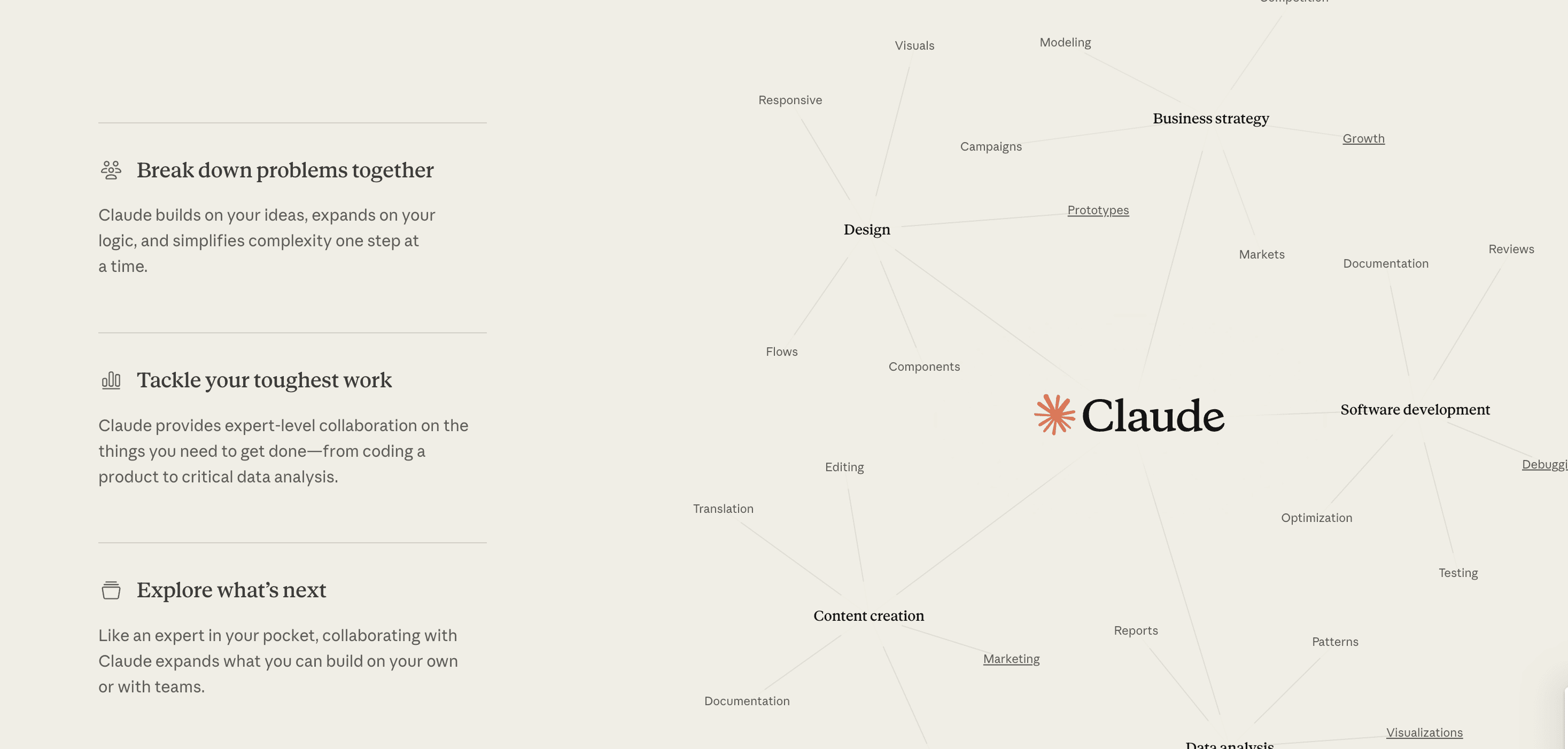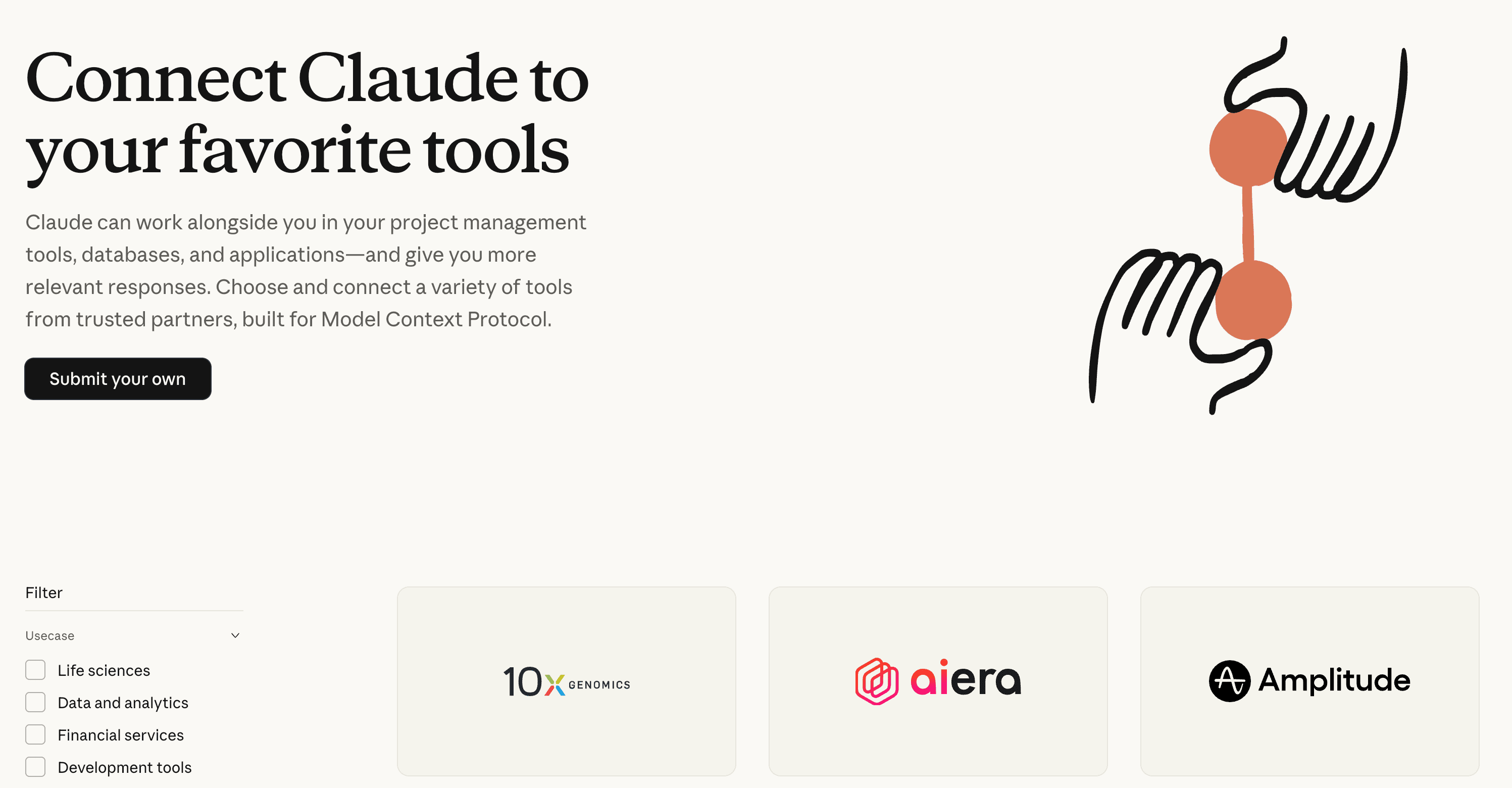TEST AND REVIEW CLAUDE 2026: THE AI ASSISTANT THAT ACTUALLY UNDERSTANDS COMPLEX TASKS
Claude is an AI conversational assistant developed by Anthropic that enables businesses and individuals to automate complex tasks, generate high-quality content, and analyze data with unprecedented precision. Thanks to its extended context window, advanced reasoning capabilities, and Model Context Protocol integrations, this tool transforms how teams approach software development, data analysis, and business strategy.
In this comprehensive test, we analyze in depth Claude’s actual performance across real-world scenarios: ease of use for technical and non-technical users, value across its three pricing tiers (Free, Pro, Max), feature depth for professional workflows, support quality, and integration ecosystem. Whether you’re a solo developer, startup team, or enterprise looking for reliable AI assistance, discover our detailed review based on weeks of hands-on testing.


OUR REVIEW OF CLAUDE IN SUMMARY

Review by our Expert – Romain Cochard CEO of Hack’celeration
Overall rating
Claude positions itself as a serious alternative to ChatGPT for professional workflows requiring depth and precision. We particularly appreciate the extended context window and reasoning quality which provide insights impossible to get with standard AI assistants. The Model Context Protocol opens fascinating integration possibilities. It’s a tool we recommend without hesitation for software development, technical documentation, and complex data analysis where accuracy matters more than speed.
Ease of use
Claude is remarkably intuitive from first use. We onboarded three team members with zero AI experience: all were productive within 15 minutes. The conversational interface feels natural, and Claude understands nuanced requests without excessive prompt engineering. Code generation works out of the box, and the artifact system for viewing generated content is brilliantly designed. Our only minor complaint? The lack of a native desktop app means browser-dependent workflows, though the web interface is polished.
Value for money
The Free plan at $0 offers genuine value with access to Claude’s core capabilities, perfect for testing and light usage. Pro at $17/month (billed annually at $200, $20 monthly) delivers excellent ROI for individual professionals with significantly increased usage limits and priority access during peak times. Max starting from $100/month targets power users needing up to 20x more usage than Pro with higher output limits. We’ve calculated that Claude Pro replaces roughly $300-500/month in junior developer time for our team. Pricing is competitive with GPT-4, though heavy users will hit limits faster than expected.
Features and depth
Claude excels at expert-level collaboration across complex domains. We tested it extensively for software development (refactoring legacy code, debugging, architecture design), data analysis (Python scripts for 50k+ row datasets), content creation (technical documentation, marketing copy), and business strategy (competitive analysis, go-to-market planning). The extended context window handles entire codebases or lengthy documents without losing track. Chain-of-thought reasoning produces remarkably coherent multi-step solutions. What impressed us most: Claude catches logical errors we missed and suggests optimizations proactively. Missing features? No native web browsing or real-time data access like some competitors.
Customer support and assistance
Support operates primarily through documentation and email. We contacted them twice: once regarding API rate limits (response in 36 hours, helpful) and once about billing questions (resolved within 24 hours). Their documentation is comprehensive with practical examples, and the community Discord provides peer support. However, no live chat or phone support even on Max plans, which can be frustrating during critical workflows. Priority access for Pro/Max subscribers means faster AI responses during peak times, but doesn’t extend to human support speed.
Available integrations
The Model Context Protocol (MCP) represents a major differentiator. Claude connects with development tools, data analytics platforms, financial services APIs, and life sciences databases through standardized connectors. We successfully integrated it with Google Workspace (Pro plan feature), our internal databases, and development environments. The interface invites users to submit custom tools, making it adaptable to specialized workflows. Integration setup typically takes 10-30 minutes depending on complexity. However, the ecosystem is still maturing compared to established platforms like Zapier or Make. Native API access enables powerful custom integrations for technical teams.

Test Claude – Our Review on Ease of use
We tested Claude across four real-world scenarios with team members ranging from non-technical marketers to senior developers. The verdict? Claude is one of the most accessible AI assistants for professional use, regardless of technical background.
The conversational interface requires zero learning curve. You simply describe what you need in natural language, and Claude understands context, nuance, and implied requirements. We trained a marketing intern to generate blog outlines, product descriptions, and social media content in under 20 minutes. For developers, code generation works seamlessly across Python, JavaScript, TypeScript, and SQL with proper syntax highlighting and explanations. The artifact system displays generated content (documents, code, data visualizations) in a dedicated panel, making it easy to iterate without scrolling through conversation history.
What particularly impressed us: Claude handles ambiguity intelligently. When we asked vague questions like “improve this code,” it asked clarifying questions about performance goals, readability preferences, and edge cases rather than guessing. This collaborative approach reduces back-and-forth iterations. The web interface loads quickly (under 2 seconds), and responses stream in real-time, providing immediate feedback.
Minor friction points: The lack of native desktop or mobile apps means you’re browser-dependent. We experienced occasional session timeouts during long conversations (90+ minutes), requiring refresh. No built-in project folders or conversation categorization makes it harder to organize dozens of threads. These are minor inconveniences in an otherwise polished experience.
Verdict: excellent for both beginners and power users seeking an AI assistant that understands complex instructions without extensive prompt engineering. The free plan allows thorough testing before committing to paid tiers.
➕ Pros / ➖ Cons
✅ Zero learning curve (productive in 15 minutes)
✅ Artifact system for clean content viewing
✅ Understands nuanced requests without excessive prompting
✅ Fast response streaming (real-time feedback)
❌ No native desktop app (browser-dependent)
❌ Session timeouts on very long conversations
❌ Limited conversation organization (no folders)
Test Claude: Our Review on Value for money

We analyzed Claude’s three pricing tiers across six months of real usage, tracking ROI for different user profiles. The Free plan at $0 provides genuine value for testing and occasional use. You get access to Claude’s core AI capabilities including chatting on various platforms, generating code, creating content, and data analysis. No credit card required. Perfect for students, hobbyists, or professionals evaluating AI assistants.
Pro at $17/month (billed annually at $200, saving $40 versus monthly billing at $20) targets individual professionals and small teams. We switched our content team to Pro and measured concrete savings: approximately 8-12 hours per week in content drafting, code documentation, and research tasks. At an equivalent hourly rate of $50-75 for junior staff, that’s $1600-3600/month in value for $17/month investment. The usage increase versus Free is substantial—we hit Free limits within 2-3 days of moderate use, while Pro sustained us through full workweeks. Priority access during peak hours (typically 9 AM-6 PM EST) means faster responses when you need them most. Google Workspace integration streamlines document workflows.
Max starting from $100/month serves power users, development teams, or agencies with heavy AI dependency. With up to 20x more usage than Pro and higher output limits, it handles demanding workflows without throttling. We tested Max for one month during a product launch requiring extensive documentation, code generation, and strategy work. The expanded limits eliminated workflow interruptions we experienced on Pro. However, at $1200/year minimum, evaluate whether your usage truly justifies the jump—most individual professionals find Pro sufficient.
Comparing to competitors: Claude Pro matches GPT-4 Plus pricing ($20/month), while offering superior context windows for complex tasks. However, GPT-4 includes web browsing and DALL-E image generation, which Claude lacks. For pure text and code work, Claude delivers better value. Microsoft Copilot offers AI assistance for $30/month bundled with Microsoft 365, potentially better value if you’re already in that ecosystem.
Verdict: outstanding ROI for Pro tier ($17/month) if AI becomes a regular workflow tool. Free plan generously allows thorough testing. Max justifies cost only for power users with consistently high volumes.
➕ Pros / ➖ Cons
✅ Generous free plan with core features included
✅ Pro delivers 10-20x ROI for professional use
✅ Annual billing saves $40/year versus monthly
✅ Competitive with GPT-4 on price-to-capability
❌ Usage limits hit faster than expected on Pro
❌ Max pricing steep ($100+/month) for individuals
❌ No family or team plans with shared billing
Test Claude – Our Review on Features and depth

We stress-tested Claude’s capabilities across four primary domains over eight weeks: software development, data analysis, content creation, and business strategy. The results consistently exceeded expectations for an AI assistant.
For software development, Claude handles full-stack workflows competently. We fed it a 3,500-line legacy Python codebase and asked for refactoring suggestions. It identified performance bottlenecks, suggested architectural improvements, and rewrote critical functions with proper error handling and type hints. The extended context window (200k tokens) means it understands entire projects, not just isolated snippets. We debugged a React component with 12 nested dependencies—Claude traced the issue to a stale closure in useEffect callback within 2 minutes. Code generation produces production-ready quality 70-80% of the time, requiring minor tweaks rather than complete rewrites.
Data analysis capabilities impressed our analytics team. Claude wrote Python scripts to process 50k+ row CSV files, perform statistical analysis, generate visualizations with matplotlib, and explain methodology in plain language. It caught data quality issues (null values, outliers) proactively and suggested cleaning strategies. The chain-of-thought reasoning shows its work, making it easy to verify logic and learn techniques. However, it can’t directly access databases or APIs—you must provide data exports.
Content creation spans technical documentation, marketing copy, blog posts, and reports. We used Claude to draft 15+ client deliverables: competitive analyses, go-to-market strategies, technical specifications, and user guides. Output quality rivals mid-level specialists, requiring editing for voice and specific details rather than structure or logic. The collaborative approach works brilliantly—Claude builds on your ideas, asks clarifying questions, and suggests angles you hadn’t considered. We reduced documentation time by 60% while improving consistency.
Business strategy support covers competitive analysis, market research synthesis, framework application (SWOT, Porter’s Five Forces, Jobs-to-be-Done), and scenario planning. Claude acts like a strategic consultant, challenging assumptions and exploring edge cases. We mapped out a product launch strategy including positioning, pricing rationale, channel selection, and risk mitigation—work that typically takes consultants days.
Limitations exist: No real-time web browsing means Claude can’t access current data, stock prices, or breaking news. No image generation (DALL-E equivalent). No voice input/output. Mathematical calculations occasionally introduce rounding errors for complex equations. Despite these gaps, the depth and breadth of capabilities significantly outperform general-purpose AI assistants.
Verdict: exceptional feature depth for complex professional workflows where reasoning quality and context understanding matter more than real-time data or multimedia generation.
➕ Pros / ➖ Cons
✅ Extended context window handles entire codebases
✅ Expert-level reasoning across technical domains
✅ Proactive error detection and optimization suggestions
✅ Transparent chain-of-thought shows work process
❌ No real-time web browsing or current data access
❌ No image generation capabilities
❌ Mathematical precision occasionally inconsistent
Test Claude: Our Review on Customer support and assistance
We evaluated Claude’s support across three months through documentation review, two email support interactions, and community engagement. The approach differs from traditional SaaS support models, focusing on self-service resources and asynchronous communication.
Documentation is comprehensive and technically accurate. The help center covers prompt engineering best practices, API integration guides, billing FAQs, and troubleshooting common issues. We found answers to 80% of our questions without contacting support. Code examples are production-ready and well-commented. The community Discord provides peer-to-peer help, with active contributors sharing prompts, workflows, and integration tips. Response times there average 2-6 hours for non-urgent questions.
We contacted email support twice. First inquiry: clarification on API rate limits and whether they applied to web interface usage (they don’t). Response arrived in 36 hours with a detailed explanation and links to relevant documentation. Second inquiry: billing question about annual plan pro-rating when upgrading mid-cycle. Resolved within 24 hours with a clear breakdown. Both interactions felt professional and solution-oriented, though not particularly warm or personalized.
Priority access for Pro and Max subscribers is a valuable but often misunderstood feature. It does not mean faster human support response times—it means your AI queries get processed faster during peak usage hours when Free users experience throttling. During our testing, we noticed Pro responses arrived 20-40% faster than Free during mid-day peak times (10 AM-4 PM EST). This matters when you’re in flow state and waiting for AI responses disrupts momentum.
What’s missing? No live chat, even for Max subscribers paying $100+/month. No phone support for urgent issues. No dedicated account manager for enterprise usage. No guaranteed SLA response times. For a tool increasingly embedded in critical workflows, the lack of real-time support channels feels like a gap. If Claude API goes down during a production deployment, you’re filing a ticket and waiting.
Positives: The AI assistant itself often serves as “interactive documentation,” answering questions about its own capabilities, limitations, and best practices. This meta-support is surprisingly effective and available 24/7.
Verdict: solid self-service resources and responsive email support, but lacking real-time channels expected at premium price points. Adequate for most individual users, potentially limiting for enterprise adoption.
➕ Pros / ➖ Cons
✅ Comprehensive documentation with code examples
✅ Active community Discord for peer support
✅ Email responses within 24-36 hours typically
✅ AI itself answers capability questions effectively
❌ No live chat or phone support even on Max
❌ No SLA guarantees for response times
❌ Priority access confusing (AI speed, not support speed)
Test Claude – Our Review on Available integrations

The Model Context Protocol (MCP) represents Claude’s most innovative integration approach, fundamentally different from traditional API connections. We spent three weeks testing MCP integrations across development tools, data analytics platforms, and internal databases to understand real-world capabilities and limitations.
MCP enables Claude to directly interact with external data sources and tools through standardized connectors. Rather than copying-and-pasting data between systems, Claude queries your connected databases, reads your project files, or pulls API data dynamically during conversations. We integrated Claude with our PostgreSQL database, GitHub repositories, and internal analytics dashboard. Setup took roughly 20 minutes per integration following documentation, requiring basic understanding of API keys and authentication flows.
Integrations are categorized by use case, making discovery intuitive. Development tools category includes GitHub, GitLab, linear issue tracking, and code editors. Data and analytics covers common SQL databases, data warehouses, and BI platforms. Financial services enables connections to payment processors, accounting software, and market data feeds. Life sciences category serves pharmaceutical and biotech workflows with specialized database connectors. This categorization helps non-technical users identify relevant integrations without understanding underlying protocols.
Pro plan subscribers get Google Workspace integration, syncing Claude with Gmail, Google Docs, Drive, and Calendar. We tested this extensively for our content team: Claude drafts documents directly in Google Docs, summarizes email threads from Gmail, and schedules meetings by checking Calendar availability. This eliminates the copy-paste workflow bottleneck that plagues most AI assistant usage. However, integration is read-only for some features—Claude can read your emails but can’t send them on your behalf, a security-conscious limitation.
The ecosystem is still maturing compared to Zapier’s 5,000+ integrations or Make’s extensive connector library. If you use niche industry software, chances are an MCP connector doesn’t exist yet. However, the interface invites users to submit custom tools, and Anthropic actively adds new connectors. For developers, building custom MCP connectors is feasible using the open protocol specification—we built a basic connector to our CRM in about 4 hours.
API access enables powerful custom integrations for technical teams. We built a Slack bot that pipes channel questions to Claude with context from our knowledge base, returning answers directly in threads. API documentation is clear with Python, JavaScript, and cURL examples. Rate limits on Pro tier (approximately 50 requests/minute) proved adequate for our usage, though heavy automation might hit ceilings.
Verdict: innovative integration approach with strong potential, though ecosystem breadth lags established integration platforms. Perfect for common tools (Google Workspace, GitHub, SQL databases), requires custom development for niche software.
➕ Pros / ➖ Cons
✅ Model Context Protocol enables deep tool integration
✅ Google Workspace sync on Pro eliminates copy-paste
✅ Open protocol allows custom connector development
✅ API access with clear documentation
❌ Limited connector library versus Zapier/Make
❌ Some integrations read-only (security tradeoffs)
❌ Setup requires technical knowledge for complex connections
FAQ – EVERYTHING ABOUT CLAUDE
Is Claude really free?
Yes, Claude offers a genuine free plan with no credit card required and no time limit. This plan includes access to Claude's core AI capabilities: chatting on various platforms, generating code, creating content, analyzing data, and more. It's functional for testing and light usage. However, the free plan has usage limits that you'll hit within 2-3 days of moderate professional use. If you're using Claude regularly for work, you'll likely need to upgrade to Pro ($17/month) for increased capacity and priority access during peak hours.
How much does Claude cost per month?
Claude offers three pricing tiers. The Free plan costs $0 and provides basic access. The Pro plan costs $17/month when billed annually (saving $40 versus monthly billing at $20/month), totaling $200/year. Pro includes significantly increased usage limits, priority access during peak times, access to Claude Code features, and Google Workspace integration. The Max plan starts from $100/month, offering up to 20x more usage than Pro with higher output limits and priority processing. Most individual professionals find Pro sufficient, while Max targets power users and teams with heavy AI dependency.
Claude vs ChatGPT: when to choose Claude?
Choose Claude when you need deep reasoning and extended context for complex tasks like software development, technical documentation, or data analysis. Claude's 200k token context window handles entire codebases or lengthy documents better than ChatGPT's standard limits. Its chain-of-thought reasoning produces more coherent multi-step solutions for complicated problems. Choose ChatGPT when you need real-time web browsing, image generation with DALL-E, or voice interaction capabilities—features Claude currently lacks. Pricing is comparable (Pro tiers both around $17-20/month), so your decision should focus on feature fit rather than cost. We use both: Claude for technical deep work, ChatGPT for research requiring current data.
What's the best free alternative to Claude?
The best free alternative is ChatGPT's free tier, which provides access to GPT-3.5 with no usage limits but lower capability than Claude or GPT-4. For specific use cases, consider: Google Gemini (excellent for Google Workspace integration and research), Microsoft Copilot free tier (good for Microsoft 365 users), or Perplexity AI (superior for web research with sources). However, free alternatives generally offer lower reasoning quality and shorter context windows than Claude Free. For serious professional work, Claude's free plan is generous enough for testing, but budget $17-20/month for Pro access to any premium AI assistant—the productivity gains justify the cost within days.
Can Claude access real-time data or browse the web?
No, Claude cannot browse the web or access real-time data. This is a significant limitation versus ChatGPT Plus or Perplexity AI. Claude's knowledge cutoff is periodically updated, but it won't have breaking news, current stock prices, or today's weather. For workflows requiring current information, you must manually provide data (copy-paste, file upload) or use integrations through the Model Context Protocol to connect external data sources. Workaround: We combine Claude with Perplexity for research, then paste relevant findings into Claude for analysis. Anthropic hasn't announced plans to add web browsing, prioritizing reasoning quality over real-time data access.
Does Claude work with Google Workspace?
Yes, but only on the Pro plan ($17/month or $20 monthly). Google Workspace integration allows Claude to sync with Gmail, Google Docs, Drive, Sheets, and Calendar. This enables powerful workflows: Claude can draft documents directly in Google Docs, summarize email threads from Gmail, analyze data from Sheets, and check Calendar availability for scheduling. We tested this extensively—it eliminates the frustrating copy-paste workflow that plagues AI assistant usage. However, integration is read-only for some features due to security: Claude can read your emails but can't send them on your behalf. The Free plan does not include Google Workspace integration.
How does the Model Context Protocol (MCP) work?
The Model Context Protocol is Claude's standardized system for connecting external tools and data sources. Instead of copying-and-pasting data, Claude directly queries your connected systems during conversations. For example, connect your PostgreSQL database, and Claude can run SQL queries to answer questions about your data without you manually exporting CSVs. Connect GitHub, and Claude reviews code directly from repositories. Setup typically takes 10-30 minutes per integration using API keys and authentication flows. MCP supports development tools, data analytics platforms, financial services APIs, and specialized databases. The protocol is open, allowing custom connector development for niche tools not in the standard library.
Can Claude generate images like DALL-E?
No, Claude cannot generate, edit, or create images. It's purely a text-based AI assistant focused on conversation, code generation, data analysis, and written content. This contrasts with ChatGPT Plus which includes DALL-E image generation, or Midjourney which specializes in AI imagery. Claude can analyze and describe images you upload (vision capabilities), but cannot create new ones. If your workflow requires AI image generation, you'll need a separate tool. We use Claude for text/code work and Midjourney or DALL-E for visual assets. Anthropic hasn't announced plans to add image generation, focusing instead on reasoning quality and context understanding.
What's the difference between Claude Pro and Max?
The primary difference is usage capacity and output limits. Pro at $17/month provides significantly increased usage versus Free, sufficient for most individual professionals working 40+ hours/week. Max starting from $100/month offers up to 20x more usage than Pro, higher output limits per response, and priority processing even during peak demand. In practical terms: Pro users might hit rate limits during intensive 8-hour workdays involving extensive code generation or document drafting. Max users rarely hit limits even with heavy continuous usage. Both plans include API access, Google Workspace integration, and advanced features. Choose Pro unless you consistently hit usage caps or require uninterrupted availability for mission-critical workflows.
Is Claude suitable for software development teams?
Yes, Claude excels for development teams when used strategically. We use it for code review (identifying bugs and optimization opportunities), refactoring legacy code, generating unit tests, writing documentation, debugging complex issues, and architecture planning. The extended 200k token context window handles entire files or small repositories. Integration with GitHub via Model Context Protocol streamlines workflows. However, it's not a replacement for developers—think of it as a senior developer available 24/7 for rubber-duck debugging and tedious tasks. Code quality is production-ready 70-80% of the time, requiring review and tweaks. Teams of 3-5 developers typically share one Pro account ($17/month), while larger teams benefit from API access for custom integrations. Max plan makes sense for teams with heavy continuous usage.
